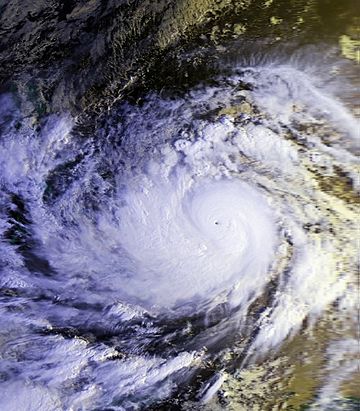Typhoon Mike facts for kids
| Typhoon (JMA scale) | |
|---|---|
| Category 5 super typhoon (SSHWS) | |

Typhoon Mike at peak intensity while approaching the Philippines
|
|
| Formed | November 7, 1990 |
| Dissipated | November 18, 1990 |
| Highest winds | 10-minute sustained: 185 km/h (115 mph) 1-minute sustained: 285 km/h (180 mph) |
| Lowest pressure | 915 hPa (mbar); 27.02 inHg |
| Fatalities | 748 direct |
| Damage | $220 million (1990 USD) |
| Areas affected | Philippines, China |
| Part of the 1990 Pacific typhoon season | |
Super Typhoon Mike was a very powerful and deadly storm that hit the Philippines in November 1990. It was known by different names, like 9025 internationally and Ruping in the Philippines. Mike was the strongest and most dangerous typhoon of the 1990 typhoon season.
Contents
How Typhoon Mike Formed and Moved
Mike started as an area of stormy weather over the Caroline Islands on November 6. It quickly became more organized as it moved west. On November 7, it was strong enough to be called Tropical Depression 27W. The next day, near the island of Yap, it grew into Tropical Storm Mike.
Mike Becomes a Typhoon
Mike kept moving west and getting stronger. On November 9, it officially became a typhoon. This was the 18th typhoon of that season. Experts thought the storm might turn north, but it kept moving straight west.
Mike's Peak Strength
On November 10, Typhoon Mike grew very quickly. It reached its strongest point with winds of 165 miles per hour (265 km/h). In just two days, its central pressure dropped a lot, showing how powerful it had become.
Mike stayed super strong for a whole day as it got closer to the Philippines. Luckily, the storm weakened a bit before it hit land. This happened because of something called an eyewall replacement cycle and because it was getting close to land. Even so, Mike still hit the eastern Philippines on November 12 with winds of 140 miles per hour (225 km/h).
Weakening and Dissipation
As Mike crossed the islands, it weakened further to 85 miles per hour (137 km/h). But once it reached the South China Sea, it got a little stronger again. On November 14, Mike reached a second peak with winds of 95 miles per hour (153 km/h).
However, when it got close to Vietnam, it weakened again. On November 15, the storm finally started to move northwest. It faced strong winds high up in the atmosphere, which made it weaker. By November 16, Mike was just a tropical storm. The next day, it passed over Hainan Island and became a tropical depression. After a short time over the Gulf of Tonkin, Mike hit southern China and disappeared on November 18.
Typhoon Mike's Impact
Template:Retired Philippine typhoon names When Mike crossed the western Caroline Islands, it caused a lot of damage. But thankfully, no one died there, and only one person was hurt.
Impact in the Philippines
The Philippines was not as lucky. Mike brought very heavy rain, which caused dangerous mudslides. The strong winds also caused a lot of damage. In total, the damage was over $14 million in 1990, which would be about $20.8 million today.
Sadly, over 748 people died because of Typhoon Mike. This made it the most destructive typhoon for the Philippines since Typhoon Ike in 1984. After the storm, the President of the Philippines at the time, Corazon Aquino, declared a special "state of calamity" in the Visayas region. This meant the area needed urgent help.
Rebuilding Cebu
Typhoon Mike caused a lot of damage to the city and province of Cebu. This made local leaders think about what was most important for their area. They worked hard to rebuild after the storm. This effort led to a big growth in Cebu's economy, which people called "CEBOOM."
Name Retirement
Because of all the destruction in the Philippines, the name "Mike" was taken off the list of typhoon names. It was replaced with "Manny." The local Philippine name, "Ruping," was also retired.
Related pages
- List of tropical cyclones
Images for kids
-
Map showing the Public Storm Warning Signal areas during Typhoon Mike.




